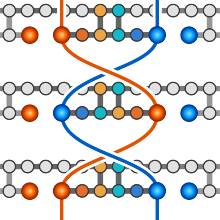Symmetry protected topological phase of interacting bosons with Rydberg atoms
The concept of topological phases is a powerful framework to characterize ground states of quantum many-body systems that goes beyond the paradigm of symmetry breaking. While a few topological phases appear in condensed matter systems, a current challenge is the implementation and study of such quantum many-body ground states in artificial matter. In this project, we studied a symmetry protected topological phase of interacting bosons in a one-dimensional lattice, which was experimentally realized by our collaborators from the “Quantum Optics – Atoms” team at Institut d’Optique. We observed a robust ground state degeneracy attributed to protected edge states. The setup was based on atoms trapped in an array of optical tweezers and excited into Rydberg levels, which gives rise to hard-core bosons with an effective hopping by dipolar exchange interaction.
- Experimental realization of a symmetry protected topological phase of interacting bosons with Rydberg atoms
Sylvain de Léséleuc, Vincent Lienhard, Pascal Scholl, Daniel Barredo, Sebastian Weber, Nicolai Lang, Hans Peter Büchler, Thierry Lahaye, Antoine Browaeys, Science 365, 775 (2019)
Topological quantum error correction with cellular automata
Active quantum error correction on topological codes is one of the most promising routes to long-term qubit storage. The starting point of this project was that, in view of future applications, the scalability of the used decoding algorithms in physical implementations is crucial. We focused on the one-dimensional Majorana chain and constructed a strictly local decoder based on a self-dual cellular automaton. We studied numerically and analytically its performance and exploited these results to contrive a scalable decoder with exponentially growing decoherence times in the presence of noise. Our results are relevant for scalable and modular designs of actively corrected one-dimensional topological quantum memories.
- Strictly local one-dimensional topological quantum error correction with symmetry-constrained cellular automata
Nicolai Lang and Hans Peter Büchler, SciPost Phys. 4, 007 (2018)
Topological states of interacting fermions
The goal of this project was the construction and study of a microscopic model of interacting fermions where the ground state degeneracy is topologically protected. The model is based on a double-wire setup with local interactions in a particle number conserving setting. A compelling property of this model is the exact solvability for its ground states and low energy excitations. We demonstrated the appearance of topologically protected edge states and derived their braiding properties on a microscopic level. We found the non-abelian statistics of Ising anyons, which can be interpreted as Majorana-like edge states.
In a follow-up study, we scrutinized the same model away from the exactly solvable point. Using a combination of bosonization as well as full scale numerical density-matrix renormalization group analysis, we mapped out the full phase diagram. We found that the topological phase survives in an extended parameter regime. Remarkably, an additional symmetry is required to protect the topological phase.
- Topological states in a microscopic model of interacting fermions
Nicolai Lang and Hans Peter Büchler, Phys. Rev. B 92, 041118(R) (2015) - Ising anyonic topological phase of interacting Fermions in one dimension
Kai Guther, Nicolai Lang and Hans Peter Büchler, Phys. Rev. B 96, 121109(R) (2017)
Majorana modes in p-wave superfluids
The core message of this project was a simple approach to create a strong p-wave interaction for fermions in an optical lattice. The crucial step is that the combination of a lattice setup with different orbital states and s-wave interactions can give rise to a strong induced p-wave pairing. We identified different topological phases and demonstrated that the setup offers a natural way to explore the transition from Kitaev's Majorana wires to two-dimensional p-wave superfluids. We demonstrated how this design can induce Majorana modes at edge dislocations in the optical lattice and provided an experimentally feasible protocol for the observation of the non-Abelian statistics.
- Majorana modes and p-wave superfluids for fermionic atoms in optical lattices
Adam Bühler, Nicolai Lang , Christina V. Kraus, Gunnar Möller, Sebastian D. Huber, Hans Peter Büchler, Nature Communications 5, 4504 (2014)
Topological bands by dipolar exchange interactions
This project addressed the realization of topological band structures by exploiting the intrinsic spin-orbit coupling of dipolar interactions in combination with broken time-reversal symmetry. The system we considered is based on polar molecules trapped in a deep optical lattice, where the dynamics of rotational excitations follows a hopping Hamiltonian which is determined by the dipolar exchange interactions. We found topological bands with Chern number C=2 on the square lattice, while a very rich structure of different topological bands appears on the honeycomb lattice. We showed that the system is robust against missing molecules. For certain parameters we obtained flat bands, providing a promising candidate for the realization of hard-core bosonic fractional Chern insulators.
- Topological flat bands with Chern number C = 2 by dipolar exchange interactions
David Peter, Norman Y. Yao, Nicolai Lang, Sebastian D. Huber, Mikhail D. Lukin, and Hans Peter Büchler, Phys. Rev. A 91, 053617 (2015)
Topological networks for quantum state transfer
Efficient communication between qubits relies on robust networks which allow for fast and coherent transfer of quantum information. It seems natural to harvest the remarkable properties of systems characterized by topological invariants to perform this task. In this project we showed that a linear network of coupled bosonic degrees of freedom, characterized by topological bands, can be employed for the efficient exchange of quantum information over large distances. Important features of the setup we considered are that it is robust against quenched disorder, all relevant operations can be performed by global variations of parameters, and the time required for communication between distant qubits approaches linear scaling with their distance. We demonstrated that our concept can be extended to an ensemble of qubits embedded in a two-dimensional network to allow for communication between all of them.
- Topological networks for quantum communication between distant qubits
Nicolai Lang and Hans Peter Büchler, npj Quantum Information 3, 47 (2017)








